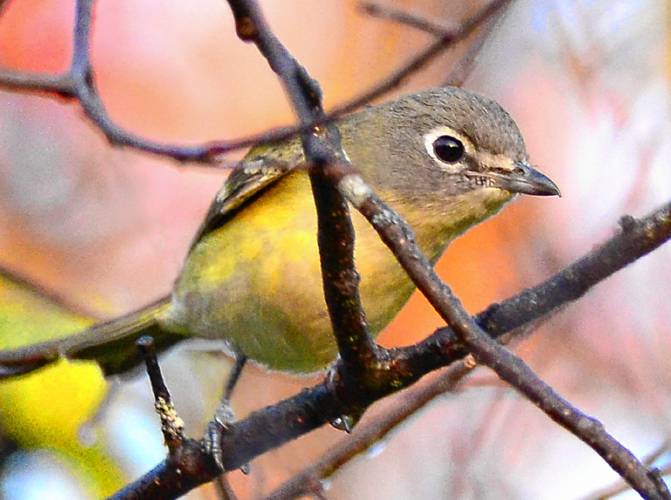Speaking of Nature: A new face among old friends — the Blue-headed Vireo

Bearing all the hallmarks of its species, this adult Blue-headed Vireo was photographed just as the sun was rising over the horizon. PHOTO BY BILL DANIELSON
| Published: 10-08-2023 10:11 PM |
Well, dear reader. I find myself presented with an increasingly rare opportunity to introduce you to a species that has not been discussed in the past 26 years of my column. As time has marched on I have seen one species of bird after another, but to see them with a camera in hand and at the ready is quite another thing indeed. Last week, during that stretch of amazing summer weather, I was in the right place at the right time to capture an image of a species that had proven elusive. And oh what a species it is.
The Blue-headed Vireo (Vireo solitarius) is a species that I first encountered back in the 90s when I worked for the U.S. Forest Service. I participated in breeding bird surveys in the White Mountain National Forest and this required that I wake at 2 a.m., drive to a survey sight and walk into the woods before it was light enough to see without the aid of a flashlight. This allowed the scientists participating to hear the very first song of a diurnal species, while also collecting the odd call of an owl.
Preparing for an event such as this meant long, joyous hours of study with a tape recorder (remember those?) and various cassette tapes of recorded bird songs. Some of the tapes were commercially available, while others had been homemade “mix tapes” of bird songs that had been put together in a jumble, which required the listener to have prepared. Identification contests could become quite competitive among the birders and we all delighted in taunting and teasing each other whenever a mistake was made. What heady days those were.
So it was there, in the forests of the White Mountains, that I first heard the songs of the Blue-headed Vireo, but at the time the species was known as the Solitary Vireo. It was John James Audubon who first described this species in 1840 and he noted that it was widely distributed across the North America, but by the end of the 20th century the “new” techniques of genetic testing revealed that one species was actually three. Our friends at the American Ornithologists Union decided that a split was in order, so the Solitary Vireo became the Plumbeous, Cassin’s and Blue-headed Vireos. Of these three species, the Blue-headed’s scientific name hints at the history of the species’ common name. This bird will always be the Solitary Vireo to me.
A glance at the range map of this species will reveal a breeding range that covers a broad swathe of Canada from the Atlantic all the way west to the easternmost sliver of British Columbia. This bird likes northern forests, but we also know that an increase in altitude can mimic an increase in latitude. Thus, there is a long spur, jutting southward out of Quebec, that follows the Appalachian Mountains as far south as Tennessee.
The forest types can vary dramatically over such a large breeding range, but the nesting habits of the Blue-headed Vireo remain the same. The male will sing his slow, sweet song to attract a female and he will show her a spot that he thinks is a good place to build a nest. When the pair finally agrees on a nesting site they both commence construction. The male will select a forked branch and start tying fibers and strips of bark around the fork so that by the time the nest is finished it is a pocket of comfort hanging from the branch like the netting on a lacrosse stick. Spider webs are an essential ingredient and they make the cup secure and somewhat flexible.
The female will lay 3-5 creamy white eggs that may have a few dark spots near the large end of the shells. The incubation period is the typical 14 or so days for a small Neotropical migrant. The nestling period is another 14 days, but the exact timing is uncertain. During the nestling phase the parents provide their chicks with a mixed diet of insects that are gleaned from the bark of branches. They tend to stick to the interior portions of a tree, but will venture out into the foliage at the tips of branches from time to time. The parents generally only have time for one clutch of eggs, but occasionally a pair will go for a second clutch.
Birds that nest up in Canada may feel like they only just got started when the days start to shorten and the urge to fly south becomes more and more irresistible. I saw one back on Aug. 23 and the bird had the distinct look of a youngster. Then, during that period of amazing summer weather last week, I caught sight of another individual. This time it was a full blown adult and it bore all of the field marks of the species.
Article continues after...
Yesterday's Most Read Articles
 Authorities ID victim in Greenfield slaying
Authorities ID victim in Greenfield slaying
 State records show Northfield EMS chief’s paramedic license suspended over failure to transport infant
State records show Northfield EMS chief’s paramedic license suspended over failure to transport infant
 Police report details grisly crime scene in Greenfield
Police report details grisly crime scene in Greenfield
 New buyer of Bernardston’s Windmill Motel looks to resell it, attorney says
New buyer of Bernardston’s Windmill Motel looks to resell it, attorney says
 McGovern, Gobi visit development sites in Greenfield, Wendell
McGovern, Gobi visit development sites in Greenfield, Wendell
 High schools: Seventh-inning rally helps Turners Falls softball edge Frontier 6-3 (PHOTOS)
High schools: Seventh-inning rally helps Turners Falls softball edge Frontier 6-3 (PHOTOS)
The head is gray with a faint bluish hue and around the eyes there is a distinctive ring of white feathers in the shape of the number 9. The throat and belly can be white with a wash of yellow deepening as you move closer to the wings, but the bird in my photo appears to have much more yellow than other individuals that I have seen. I particularly like this week’s photo because it shows the bird surrounded by a wash of fall color in the background. You can also see a reflection of the rising sun in its eye.
Birds will continue migrating, but weather like we had last week will probably not occur again this year. Don’t let that discourage you from getting out and enjoying the sights and sounds of nature, because there is still plenty to see. Blue-headed Vireos may travel as far south as Costa Rica for the winter, but other species will pour out of Canada and spend the winter here with us. Nature has much more to offer to anyone willing to go out in search of it.
Bill Danielson has been a professional writer and nature photographer for 26 years. He has worked for the National Park Service, the U.S. Forest Service, the Nature Conservancy and the Massachusetts State Parks and he currently teaches high school biology and physics. For more in formation visit his website at www.speakingofnature.com, or go to Speaking of Nature on Facebook.

 Speaking of Nature: Indulging in eye candy: Finally, after such a long wait, it’s beginning to look like spring is here
Speaking of Nature: Indulging in eye candy: Finally, after such a long wait, it’s beginning to look like spring is here Celebrating ‘Seasonings’: New book by veteran preacher and poet, Allen ‘Mick’ Comstock
Celebrating ‘Seasonings’: New book by veteran preacher and poet, Allen ‘Mick’ Comstock Faith Matters: How to still the muddy waters of overthinking: Clarity, peace and God can be found in the quiet spaces
Faith Matters: How to still the muddy waters of overthinking: Clarity, peace and God can be found in the quiet spaces A time for every purpose under heaven: Free sing-a-long Pete Seeger Fest returns to Ashfield, April 6
A time for every purpose under heaven: Free sing-a-long Pete Seeger Fest returns to Ashfield, April 6
